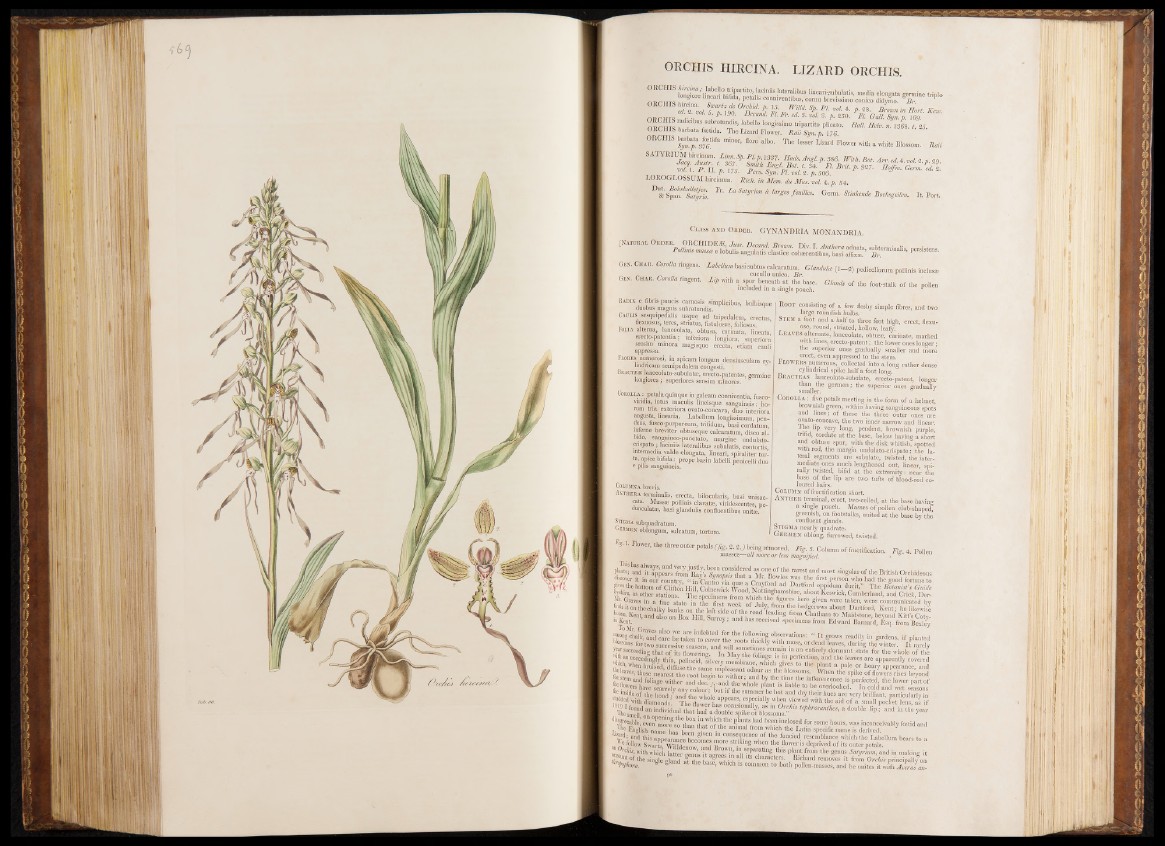
ORCHIS HIRCINA. LIZARD ORCHIS.
O E C m S l t a « u i i < i b u I « l B b media elongata germine triplo
‘ 8 e 1,“ea" b,lld“’ P°lal,s conn.ventibus,'cornu brevissi.no conico didymo. Br.
CXVuIIIo nircina. Sxoartz dc Orchid a ixf'iiiA p* t>/ ? —
ed 2 m l T T i n n n " M If W& PL M 4 ' A 28- f in » » 1» -Hór*. JEcw.
o r p h t s h -'k ; P' 9 Decand- FL Fr- cd- 3- 5. p . 250. FI. Gall. Syn.p. 169.
n p r m « h dr bUV UbJr0t“ndlS’ labolI° lon8issimo tripartite plicate. Ball. H d v . » 1368. t. 25
ORCHIS barbata foetida. The Lizard Flower. Rail Syn.p. 176
° E C)HK t e b a t e ^ t id a minor, flora' albo. . The leaser Lizard Rower with a white Blossom. Rail
SATYRIUM hircioum. Linn Sp. PI.M 1337 Huds.Angl. p. 386. With. Bat. A n ,c l. 4. ml. 2 .p . 2fl.
LOEOGLOSSUM hlrcinum. Rich, in Mem. iu Mm. ml. 4. p . 54.
D & sfa n f4s f ^ S . Fr' Z aS a ‘!/r im ^ torges f m ille . Germ.- Bocbgcilen. It. Port.
Class a n d Oe d e e . GYNANDRIA MONANDRIA
Gen. Ce a e . Corolla ringeos. basi snbtnscalcaratum ö t a & t e ( 1 - 2 ) pedicellorom pollinia inclus*
n n ~ n n . cucullo unico. Br.
' " ngent !> wift Q ,a n d s ° f tKe f“ < * * ■ P » « »
Kadis e fibris paucis carnosis simplicibus, bulbisque
düobus magnis subrotundis.
Caulis sesquipedalis usque ad tripedalem, erectus
flexuosus, teres, striatus, fistulosus, foliosus. *
Folia alterna, lanceolata, obtusa, carinata, lineata
erecto-patentia ; inferiora longiora, superiora
sensim minora magisque erecta, etiam cauli
appressa.
Flores numerosi, in spicam longam dènsiusculam cv-
lindricam semipedalem congesti. g
Bracteæ knceolato-subulatæ, erecto-patentes, germine
longiores j superiores sensim minores.
Corolla: petala quinque ingaleam conniventia, fusco-
viridia, intus maculis lineisque sanguineis: ho-
rum tria exteriora ovato-concava, duo interiora
angusta, linearia. Labellum longissimum, pendens,
fusco-purpureum, trifidum, basi cordatum,
lnferne breviter o.btuseque calcaratum, disco al-
. °» saugumeo-punctato, margine undulato-
enspato ; lacmiis lateralibus subulatis, contortis
intermedia valde elongata, lineari, spiraliter tor-
ta, apice bifida: prope basin labelli penicelli duo
e pins sanguineis.
Columna brevis.
Anthera terminalis, erecta, bilocularis, basi unisac-
cata. Massæ pollinis clavatæ, viridescentes, pe-
dunculatæ, basi glandulis confluentibus unitæ.
Stigma subquadratum.
ermEn oblongum, sulcatum, tortum.
Root consisting of a few fleshy simple fibres, and two
large roundish bulbs.'
Stem a foot and a half to three feet high, erect, flexu-
| ose, round, striated, hollow, leafy.
Leaves alternate, lanceolate, obtuse, carinate, marked
with lines, erecto-patent; the lower ones longer ;
the superior ones gradually smaller and more
erect, even appressed to the stem.
Flowers numerous, collected into a long rather dense
cylindrical spike half a foot long.
Bracteas lauceolato-subulate, erecto-patent, longer
than the germen;.the superior ones gradually
smaller. . ° J
Corolla : five petals meeting in the form of a helmet,
brownish green, within having sanguineous spots
and lines j of these the three outer ones are
ovato-concave, the two inner narrow and linear.
The lip very long, pendent, brownish purple,
trifid, cordate at the base, below havino- a short
and obtuse spur, with the disk whitish* spotted
with red, the margin undulato-crispate; the lateral
segments are subulate, twisted, the intermediate
ones much lengthened out, linear, spirally
twisted, bifid a t,th e extremity: near the
base , of the lip are two tufts o f blood-red coloured
hairs.
Column of fructification short.
An t h e r terminal, erect, two-celled, at the base having
a single pouch. Masses o f pollen club-shaped,
greenish, on footstalks, united at the base by the
confluent glands.
Stigma nearly quadrate.
Ge rm en oblong, furrowed, twisted.
% 1. Flower, the three outer petals (fig, 2 . 2. ; being removed. F,g. 3 . Column of fructification. Fig. 4 Pollen
masses—all more or lees magnified. . - — a uen
f r Mid it appears from Mr Bowie 1 , " s,nSul!ar of the British Orchideous
*■“>» it in ouV country, f r f r , « « person who hod the good fortune to
8« the bottom of Clifton Hill c X w c l n S d 1 B I °?Pldum duc,t” The Botanist’s Guide
f r 9 1 3 1 station, fmm “ d
f j 9 raves in a fine state in the first week of Inlv fr™ i f i f ve M,eie ta^en, were communicated by
8sds.it on the chalky banks on the left side of L r o S f r r° f r CIT S about Kent; he likewise
f r . Kent, and also on BoxHiU Surrev I d h„ f J 8 f"?“ Chathl,n to Maidstone, beyond Kill's Coty-
111 Kent. ° x “ ,U' bl,rreK • "lld has te c em d specimens from Edward Barnard, Esq. from Bexley
To Mr. Graves nlo« nra :_i .u . j r. ^
ainoiio- clnii/aVei a^S0 ?ve aie i°debted for the following observations: “ I t erows rpadilv in miJ«nc ;f i i
“« i s & dsf r e s * f r ™ f r V h!i,r0° lS ,tbiiCkly f r ordendlcavcs, dW io ltew in tï; i K
S C ” been Ü v e n ^ ' S f i s ' p t ó f i f u ^ e T d S f r “ 7 f °°Üda”d